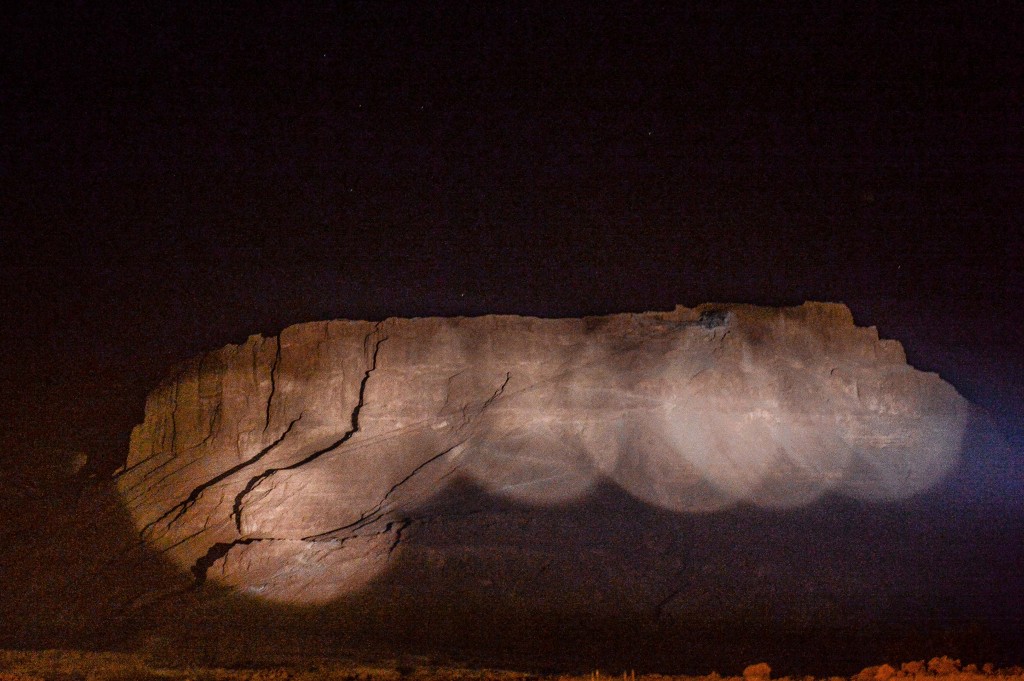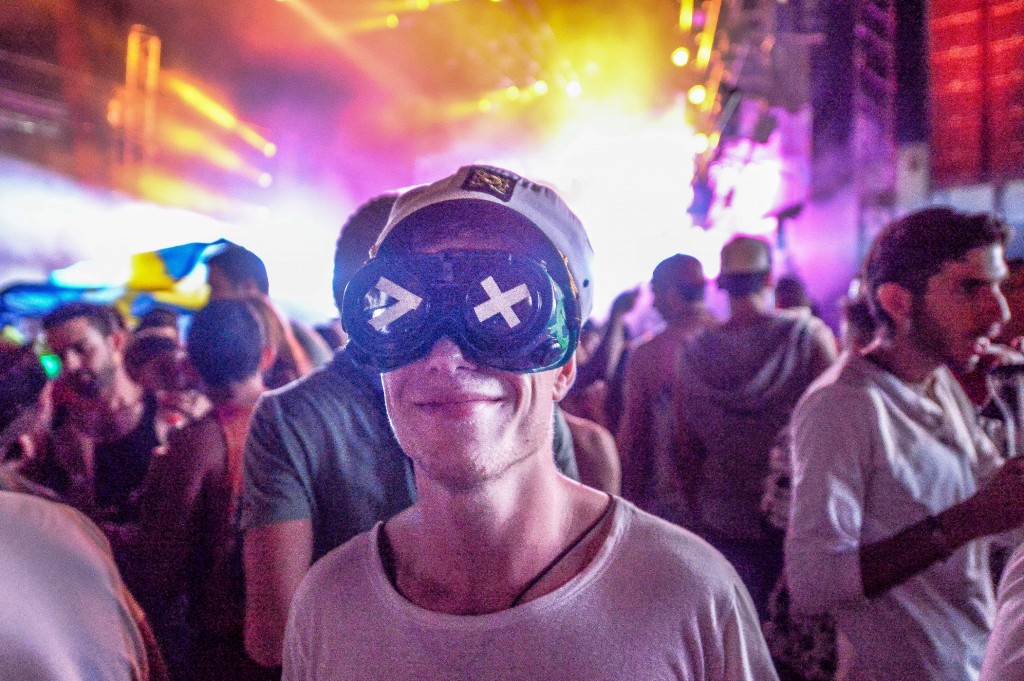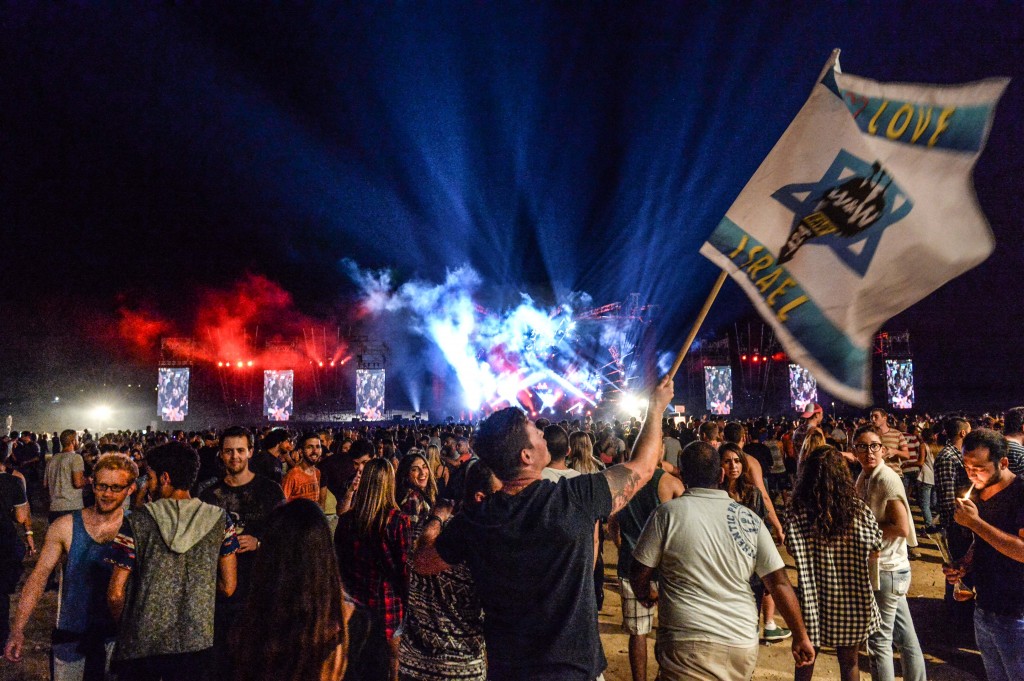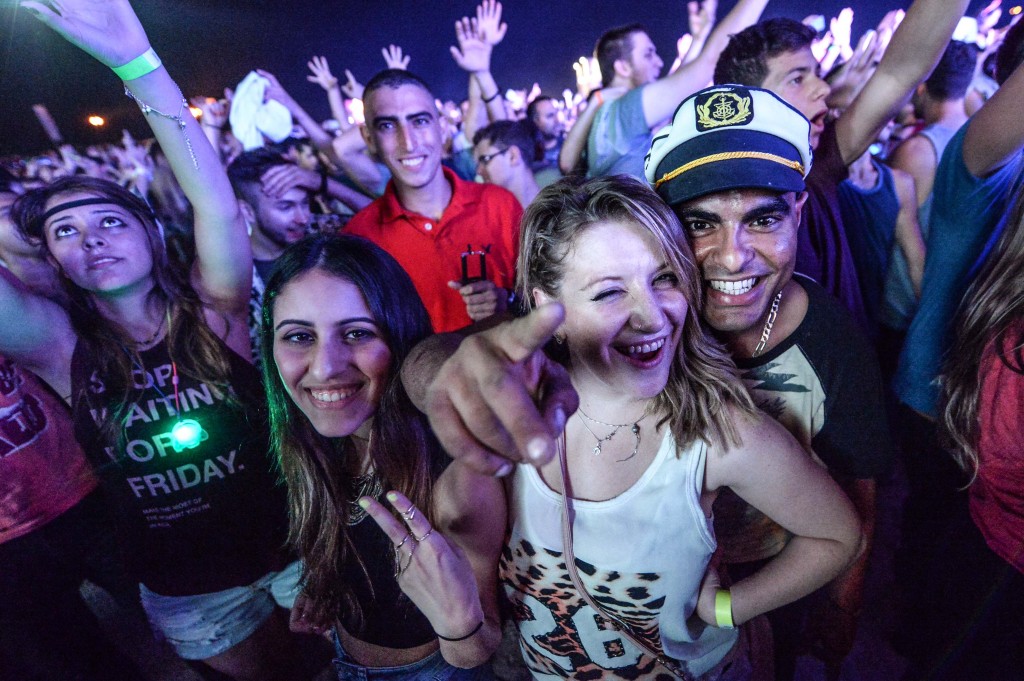Masada may seem like an unlikely place to have a rave—but for thousands of Israelis looking to blow off steam after a stressful summer, it was the perfect setting. Photos: Aviram Valdman
Driving south from the bustling cityscape of Tel Aviv through the silent serenity of the desert night, loud booms and bright lights suddenly shatter the stillness in the air. As the imposing sight of the ancient mountain fortress of Masada grows larger, the booms become louder, the lights brighter.
These aren’t the uncomfortably familiar booms heard throughout southern Israel during this summer’s war in Gaza. These are the booms of a phenomenon that, even in Israel, is more common than war. They are the booms of an electrifying bass that pounds faster and faster as it radiates from a giant stage at the foot of Masada.
Built by the Judean King Herod, Masada became legendary as the last holdout of Jewish rebels in the Great Revolt against Rome in 70 CE. With the Temple destroyed and the revolt crushed, the defenders held out against a year-long Roman siege until, faced with certain defeat, they committed mass suicide rather than submit to death or slavery.
Tonight, however, Masada is a scene of intense life, not death. The normally breathtaking site is even more awe-inspiring than usual, illuminated by stage lighting for the Dead Sea Rave, an overnight dance-fest held 424 meters below sea level. The juxtaposition of this sacred, historic site with the scene on the ground this October night in 2014 couldn’t be more dissonant. Or, from a different perspective, not so dissonant at all. Perhaps this is a biblical scene of debauchery, simply transferred to modern times.
More than 12,000 revelers, young and old, Arab and Jewish, religious and non-religious, Israelis and tourists, enter the outdoor event space through a massive archway that asks, “R U Ready 2 Escape?” And they are. Dressed in sequins, neon shirts, animal masks, and other bodily decorations, partygoers wave glow sticks as they fist-pump to the sounds created by top international DJs.
The theme of the night is to party at the lowest point on earth from sunset to sunrise, reflected by the event’s name—Dead Sea Rave -424. In contrast to the event’s geographical setting, “People feel that they are elevated by the music and elevated by dancing with like-minded people,” says Avi Yosef, a founding partner of the -424 Festival. Yosef is the international promoter for Zappa Group, Israel’s leading music production company, which co-produced the festival along with the Tamar Regional Council and Factor Forum, an event production company. “You’re coming to the lowest place to get elevated to the highest place,” he adds.
The cloud of marijuana smoke hanging over the audience may help with that. Raves are known for attracting the use of hard psychedelic drugs like ecstasy and LSD. But according to Yosef, there were no drug-related problems such as arrests, dehydration, or hospitalization at this year’s rave. In general, people were simply there to have fun. As aggressive as trance and Electronic Dance Music (EDM) can be, the scene is of an innocent sort of hedonism. A number of people dance with crowns of flowers in their hair or around their necks, others drape themselves in Israeli flags or wave them to the beat.
Now in its second annual year, the $1.3 million, 12-hour festival featured a mix of top international DJs along with Israeli EDM duo Vicky and Nella. Starting at 7:30 PM, the music picked up speed as the night transpired, with Iranian-American tech-house group Deep Dish performing at 10:30 PM; followed by Dutch EDM DJ Sander Van Doorn, who took the stage at 12:30 AM to screams and applause from the crowd, who seemed to know all the words to his tracks. The music and dancing raged on with another Dutch EDM sensation, W&W, performing at 2:00 AM; and English trance DJ Paul Oakenfold greeted the crowd at 5:00 AM. The beat went on until 7:00 AM that morning.
It was an impressive feat, especially considering the fact that Yosef and his team planned the festival in just six weeks. Like many other cultural events this summer, -424 had to put its plans on hold because of the war in Gaza. But while most events were canceled, including concerts by Neil Young, the Backstreet Boys, and the Isle of Dreams Festival, which was also set to showcase Israeli EDM, Yosef simply waited for the war to end.
“When you plan this kind of festival, you start seven or eight months before,” he says. “We had to reach out to artists and see who was interested in coming to Israel, which just a minute ago got out of war. Most of them weren’t available on such short notice.”
War wasn’t a problem last year, when the first Dead Sea Rave was headlined by David Guetta, arguably the most famous DJ on earth. More than 20,000 people from Israel and abroad showed up for the event. Four months after his performance, Guetta released a 13-minute YouTube video reflecting on his experience. Featuring images and music from his show and brief interviews with fans, the video is a love letter to Israel in which Guetta describes the powerful feelings he felt when he first laid eyes on Masada, and how moved he was by his fans and the energy there.
So far, the video has nearly 10 million views and counting. “He’s Israel’s best ambassador,” says Yosef.
Yosef also mentions one of this year’s most unusual performers: Deep Dish, made up of two Iranian-American DJs, Ali Shirazinia and Sharam Tayebi. They also love Israel, he says. In fact, they’ve visited the country several times, playing for crowds of thousands in Tel Aviv nightclubs. “They have nothing against Israel—the opposite,” says Yosef, who has known the duo for years. “Some of their best memories are from parties they went to here. They said they couldn’t wait to have some decent hummus and tehina; so in their artist room we set them up with plates of hummus, tehina, and labaneh.”
This world exposure explains one of the strangest aspects of the rave: It receives government support. Indeed, the Israeli Tourism Ministry promoted this year’s event around the world. In a press release inviting international journalists to cover the show, the ministry heralded the potential of music tourism and welcomed “the musical culture of the future.”
“Cultural tourism is a new and growing niche market for Israel that the Tourism Ministry is working to promote, in cooperation with the private sector and cultural bodies,” Tourism Minister Uzi Landau said in a statement:
The unique desert landscape at the lowest place on earth, with the Masada fortress as the backdrop, is indeed an enchanting “escape” venue for annual events as varied as the Dead Sea Rave -424 and the Israeli Opera Festival. These festivals, in conjunction with concerts by major international artists—such as Lady Gaga, Rihanna, and the Rolling Stones—attract a different type of tourist to our country. They also help position Israel as an attractive tourism destination, offering standard international culture alongside unique religious, historical, and leisure tourism options.
Yosef emphasized the positive impact that events like this one—and cultural tourism in general—have on Israel’s lackluster image around the world. Because the success of last year’s festival contributed to the popularity of Israel as a country, the Ministry of Tourism and Foreign Relations have backed us up this year,” he said. With the help of the Tourism Ministry, 51 foreign media outlets asked to cover this year’s rave, compared to just three or four last year. The ministry’s promotional support helps explains how 12,000 people from around the world came to attend an event that was planned in a mere six weeks.
While the tourism ministry might just be developing an awareness of this “musical culture of the future” and the idea of Israel as a global destination for electronic music, raves have been a staple of Israeli culture for decades and Israeli DJs are recognized as leaders of the international electronic music scene. Israeli artists like Infected Mushroom—a psychedelic trance group that began in Haifa but is now based in Los Angeles, and performed at the Dead Sea Rave—DJ Skazi, Offer Nissim, DJ Yahel, Shlomi Aber, and others have been ranked among the world’s top 100 DJs by DJ Magazine several times.
“Israel has always been influential when it comes to electronic music,” says Infected Mushroom’s Amit Duvdevani. “For many years this small country has been producing some of the most groundbreaking artists in trance and techno. Israel gave birth to the modern psy [psychedelic trance] movement.” Indeed, Infected Mushroom is still known as the leader of the psy-trance scene, responsible for bringing this once-fringe music to the masses.
“We have Israeli artists who are common international household names, such as Astrix and Borgore. Israeli artists are being championed at massive festivals such as Ultra and EDC,” says Duvdevani, referring to two of the biggest international electronic music festivals. Last year, Infected Mushroom played at Tomorrowland, the world’s largest such festival. “This has a spillover effect on the reputation of Israeli dance music in general,” Duvdevani continues. “Now there are reputable artists of all genres, including house and techno, who are traveling to Tel Aviv as a dance music destination.”
Indeed, there’s a reason why Tel Aviv now shares New York’s nickname as “the city that never sleeps.” It is consistently named one of the world’s best cities for nightlife, in large part due to its thriving electronic music and dance scene. Competition is intense, forcing artists to develop their talents to the utmost in order to succeed.
So, how and when did trance, raves, and electronic music become such a large part of Israeli culture?
Strangely enough, it all started in India. This might sound like a great distance for a musical genre to travel, but if you’re familiar with modern Israeli life, it makes perfect sense. Life for the average Israeli today almost always entails emotionally preparing for army service as an adolescent, serving three psychologically and physically challenging years in the IDF, and then cleansing themselves of all this stress by traveling outside the country for anywhere from three months to a year. Today, this journey brings Israeli travelers to many locations; but one of the most popular destinations is and has always been India.
“India is a melting pot of travelers from all over the world, but the Israeli travelers were the ones who adopted it in a very committed way,” says Eyal Yankovich, who used to DJ and still carries major weight in the psy-trance scene. He is now the founder and manager of the Israeli agency HOMmega Productions. It was in Goa, India, that the first big psychedelic trance parties took place in the late 1980s and early ’90s.
“These travelers by nature were people looking for freedom,” says Yankovich. “They finished the army, took a big trip and discovered this new kind of freedom. And they got hit by this music exactly when they were celebrating this first feeling of freedom. So it was good chemistry, because they wanted to extend that feeling of freedom when they came back.”
Once these travelers returned to Israel, they became the pioneers of Israeli psy-trance, creating labels and holding raves that were embraced by young Israelis seeking an escape from the chaos of life in a turbulent country. Psy-trance is much faster than a standard mainstream dance track, averaging 145 beats per minute (BPM), compared to the usual 120 BPM. Israelis seized upon this in order to develop a more frenzied, releasing form of the genre.
By the mid-‘90s, raves, trance, and electronic music had become “as Israeli as Hora and Hummus,” says Nissan Shor, an Israeli journalist and author of Dancing With Tears in Our Eyes, a history of Israeli dance culture. He believes it was all about timing: In the mid-90s, the timing was perfect. “The Oslo accords were signed; Israel started to open up, head on, to capitalism, and to the promise of peace,” he says.
Even Rabin’s assassination had been forgotten because Israel’s youngsters wanted to shed the skin of history and Zionism. Electronic music was the right soundtrack, as it embodies the Israeli temper—bursting with energy, intense and reckless. It was as if everybody took ecstasy and partied at house, techno, and trance raves and clubs; forgetting themselves, and there was a lot to forget.
While the political climate may have changed since the 90’s, the desire to escape hasn’t. “The political situation here is a never-ending catalyzer for escapism,” says Shor.
Young Israeli people party hard, as if it’s their last day on earth. At least it used to be like that at the turn of the new millennium, when suicide bombers hit Tel Aviv on a weekly basis. Now it’s just something you do between military operations and missile strikes. It became a recreational hobby for the jaded generation.
Yosef believes raves are attractive because they bring people together. And in Israel, that might be more important than anywhere else. “Music unifies people. Music has no borders. It’s a universal fact,” he says, noting that last year’s rave with David Guetta brought people from Egypt and Jordan to party with Israelis at Masada. “We just need to continue to do what we’re doing, no matter what people’s religion or nationality is.”
Unfortunately, despite the hopes of Yosef or the Israeli Tourism Ministry, sometimes bringing people together with music isn’t quite enough to counter negative perceptions of Israel. Guetta’s video, along with its 10 million views, also attracted a multitude of hateful comments. The top comment read simply, “amazing party… but fck isreal.” Another reads, “Israeli People Party, And Palestinian civilians get killed, babies and women by Zionist Forces.”
In his video, Guetta talks about the legendary story of Masada. At one point, he reflects in awe at the Jewish rebels’ “symbol of resistance,” seemingly unaware of the meaning the word holds for critics of Israel today. Commenters—most of them big fans of Guetta—jumped on that statement, accusing the artist of spouting Israeli propaganda, abandoning the “real” resistance.
Still, the people who attended this year’s Dead Sea Rave weren’t thinking about politics; including the Israeli–Arab attendees, who constituted approximately 20 percent of the crowd that night; roughly equivalent to their percentage of the Israeli population.
“It doesn’t matter where we’re from here. We’re here for the music. We’re here to dance,” said 24-year-old Omar, who attended last year’s rave as well. He and his two friends, Muspika and Mir, were taking a break from dancing while Deep Dish performed, saving their energy for Sander Van Doorn. Standing at tables in the food vendor area, the three young men were surrounded mostly by Israeli Jews, some of them wearing or holding Israeli flags. They said they felt perfectly comfortable, but preferred not to divulge their last names.
Just one night before, an Arab man from the East Jerusalem neighborhood of Silwan had driven his car into a group of pedestrians in the Ammunition Hill area of Jerusalem. The terror attack claimed the life of a three-month-old Jewish girl and a 22-year-old Ecuadorian woman who came to Israel to complete her conversion after discovering that she was descended from conversos, Spanish Jews forcibly converted to Catholicism in the 15th and 16th centuries.
Omar, Muspika and Mir traveled to the festival by bus from their homes in the East Jerusalem neighborhood of Shuafat, the scene of some of the most violent riots this summer following the murder of Arab teenager Muhammad Abu Khdeir by Jewish extremists.
“It was a hard summer,” said Muspika. “We just want to have fun.”
![]()
Banner Photo: Aviram Valdman / The Tower









